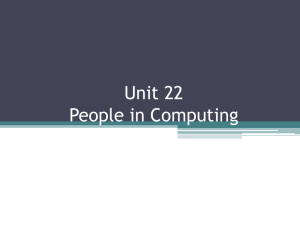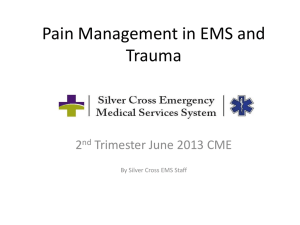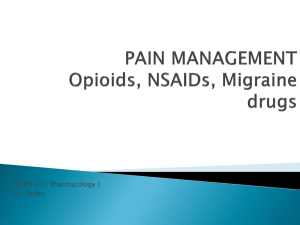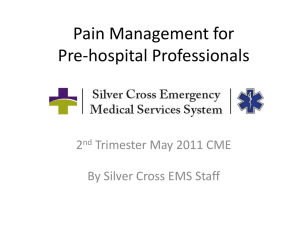Dr Heide Feberwee Pain specialist
advertisement
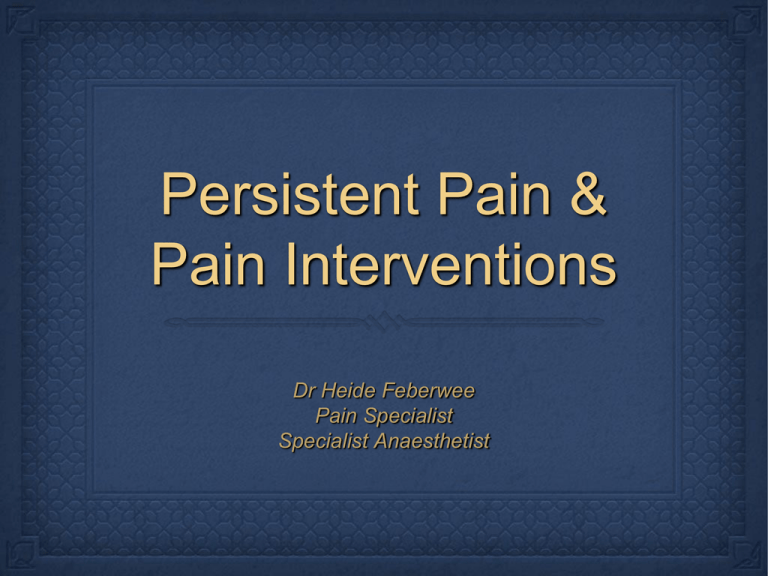
Persistent Pain & Pain Interventions Dr Heide Feberwee Pain Specialist Specialist Anaesthetist Persistent Pain Pain present for more than 3 months. Persistent Pain is a chronic disease. Associated with anatomical changes in the body. Affects 20% of the population (3.5 M). High utilization of healthcare resources. Labour intensive. Persistent Pain Managing pain is a long term process like all chronic diseases. Patients often have flare ups & multiple sites of pain. Often associated with complex medical and psychosocial history. Patient and healthcare practitioner distress is common. Managing long term pain and having strategies to deal with flare ups are important. Approach Multidisciplinary team approach important in dealing with all aspects of patient care. Pain specialists, Psychiatrists, Neurosurgeons, Rehabilitation Specialists, Practice Nurse, Psychologists, Physiotherapists, Occupational therapists worth considering. Palliative Care for terminal patients. Group sessions including Pain Management Program, hydrotherapy, mindfulness stress based reduction. Role of Pain Specialist Specialist with the Faculty of Pain Medicine ANZCA (FFPMANZCA). Already a specialist in another field e.g. Anaesthesia, Psychiatry, Addiction Specialists, Rehabilitation Medicine, General Practitioners etc. who are further trained in Pain Medicine (extra 1-2 years plus exam at an accredited multidisciplinary Pain Management unit). Biopsychosocial approach to pain management. Consultation looks at full pain history, treatment history, psychological and social issues. Role of Pain Specialist Physical exam directed specifically at areas of pain and aspects thereof that may be targeted with treatment. Screening for ‘red flag’ conditions – serious conditions that has significant morbidity. Comprehensive report and possible management strategies outlined. Further investigations ordered / suggested as needed. Pain condition discussed with patient & questions answered. Role of Pain Specialist Advice on drug management including complex opioid related issues (some may be DDU directed). Depending on skill set & interest some acquire Pain Interventional management skills. Diagnostic & therapeutic Interventional procedures can be offered. Referrals with adequate information including previous specialist reviews and results (laboratory, radiology etc.) useful. Role of Pain Specialist • Patients with pure addiction problems should see also be referred to ATODS / Addiction Specialist. • Active suicidal patients & psychosis should be treated as per normal guidelines first. • Workcover can occasionally complicate treatment if ongoing claims / litigation. • Look at non-pharmacological, pharmacological and interventional aspects of pain management. Red flags Possible fracture Possible tumour or infection Possible significant neurological deficit • Age >50 or <20 years • History of cancer • Constitutional symptoms • IV drug use • Immunosuppression • Pain worsening at night/when supine • Severe or progressive sensory alteration or weakness • Bladder or bowel dysfunction From history • Major trauma • Minor trauma in elderly or osteoporotic From physical examination • Evidence of neurological deficit High acuity cases Complex Regional Pain Syndrome (CRPS). CA pain, especially with limited life expectancy. Adolescents & parents looking after young children. Threatened loss of employment. Consideration for severe psychological impact of pain. CRPS • Complex Regional Pain Syndrome. • Debilitating syndrome with sudden onset, can be after major (type 2) or minor trauma (type 1). • Swelling / sweating, colour changes, sensory (pain), motor dysfunction / atrophy. • Need signs and symptoms in all categories. • Timely (early) treatment has best outcome. CRPS hand CRPS foot Thermal imaging CRPS Interventions for CRPS • Depending limb affected, different types of sympathetic blocks can be offered – stellate ganglion blocks, brachial plexus blocks, lumbar sympathectomies, ankle blocks. • Normally done as a series of 5 procedures. • Physiotherapy critical in keeping limb moving. • Procedure provides window of opportunity for patient to engage in active therapy. Chronic Back Pain • Very common. • Often multiple causes contributing to pain. • May be recent onset or long standing. • Surgery may not be indicated or pain may be ongoing after surgery. • May be associated with radicular pain. Chronic Back Pain • Significant relationship between gender, age, BMI & structural causes of CLBP. • Lumbar internal disc disruption is more common in young males while facet joint pain is more common in females with increased BMI. • Female gender and low BMI is associated with sacroiliac joint pain. Multivariable Analyses of the relationship between age, gender and body mass index and the source of chronic low back pain. De Palma et al. Pain Medicine 2012;13:498-506. Chronic Back Pain • Young adult (20-35) internal disc disruption (IDD) most likely source of pain (70-98%), regardless age or gender. • Over age 50, IDD is the most likely source (40-65%) except for females with low BMI (<18.5) where SIJ pain is more likely (49%). • Males > 65 facet joint pain is most likely (30-54%), regardless BMI. • Females > 65 FJP most likely (46-57%) when BMI 30-35 & SIJ pain more likely when BMI <25. • Males > 80 have other sources of CLBP (47-53%) when BMI <30 & FJP (49%) when BMI >35. • Females >80 had SIJP (45-62%) when BMI <25 & FJP (47-58%) when BMI >30. Multivariable Analyses of the relationship between age, gender and body mass index and the source of chronic low back pain. De Palma et al. Pain Medicine 2012;13:498-506. Chronic Back Pain • Need to exclude ‘red flags’. • Radiological appearance may not coincide with area of pain. • Need clinical examination to ascertain pain contributors. • Facet joint & Sacroiliac joint common causes for pain. Facet joints Chronic Back Pain • Other causes include cluneal nerve neuropathy, piriformis syndrome, greater trochanter bursitis. • Diagnostic followed by therapeutic procedures possible for these. • Often trial injections followed by radiofrequency neurotomies done. • Caudal epidural / lumbar epidural with local anaesthetic and steroid may be useful. RF neurotomy facet joint nerves Radiofrequency neurotomies FJs RF FJ & SIJ RF FJ & SIJ Cluneal nerve Spinal Cord Stimulators • Has a place for especially chronic back pain post surgery. • Specific guidelines for usage. • Conservative management strategies exhausted. • Normally trial done followed by permanent implant. Spinal Cord Stimulators Head & Neck Pain • Many causes for headaches. • Drug management needs optimization. • Interventions can be done for Greater Occipital Nerve neuralgia, Cervical facet joint disease. • Trial injections followed by RF. • Advice on drug management. Shoulder Pain • Very common. • Possible to treat most causes of shoulder pain, before & after surgery & where not indicated. • Frozen shoulder syndrome common & overuse e.g. wheelchair bound spinal injury patients. • Trial suprascapular nerve block followed by RF. Suprascapular nerve block Other Pains • Can do scar injections post procedures, especially with neuropathic pain post caesarean sections / hysterectomy, mastectomy scar pain etc. • Neuroma injection for amputees. • Intercostal nerve Phenol injections for infiltrating chest wall tumours (palliative care). • Many others directed at specific conditions including knee joint injections. Pharmacological treatment Drug treatments Paracetamol NSAIDs Tramadol Opioids / Mor-NRI Antidepressants Anticonvulsants – Pregabalin / Gabapentin NMDA antagonists Opioids • Schedule 8 drugs. • Regulatory requirements as drugs of abuse / addiction. • DDU oversees prescribing in QLD. • Need to have a single opioid prescriber (GP). • Consider opioid contract even for trial. • Universal precautions & opioid risk screening tool. Opioid potency - OMED • OMED = Oral Morphine Equivalent Dose • 10mg Oxycodone = 20mg Morphine • 10mg Methadone = 70-140mg Morphine • 8mg Hydromorphone = 40mg Morphine • 12mcg/hr Fentanyl patch = 40mg Morphine • 5-20mcg/hr Buprenorphine patch = 10-50mg Morphine (up to 90mg) • 100mg Tapentadol = 40mg Morphine • Dose above OMED 90 - 120mg per day considered high dose. Universal precautions 1. Diagnosis with appropriate DDx. 2. Psychological assessment incl. addiction risk. 3. Informed consent. 4. Treatment agreement. 5. Pre & post interventional assessment of pain & level of Fx. Universal precautions 6. Appropriate trial of Rx & adjuncts. 7. Reassessment pain score & Fx. 8. Regularly assess the 4 A’s. 9. Periodically review Pain Dx & comorbidities incl. addiction disorders. 10. Documentation. Conclusion • Multiple sites of pain can be targeted. • Need to address other aspects of patient care, including drug management, psychological stressors and social issues. • Team of healthcare practitioners useful to reduce burden of care. Questions ?


